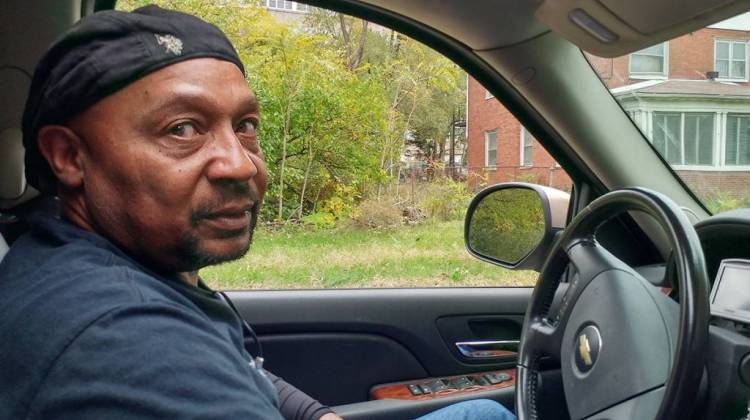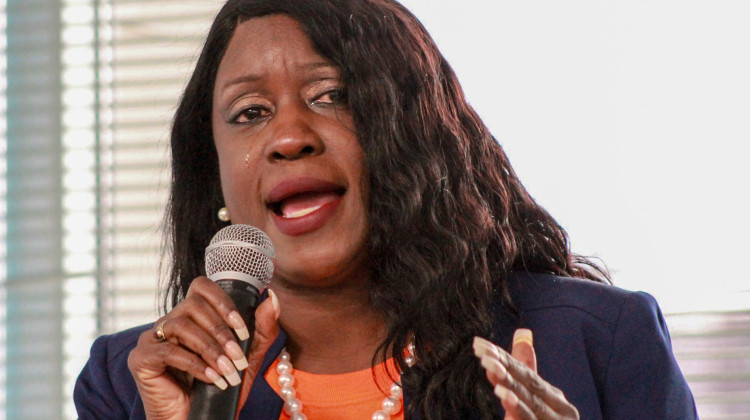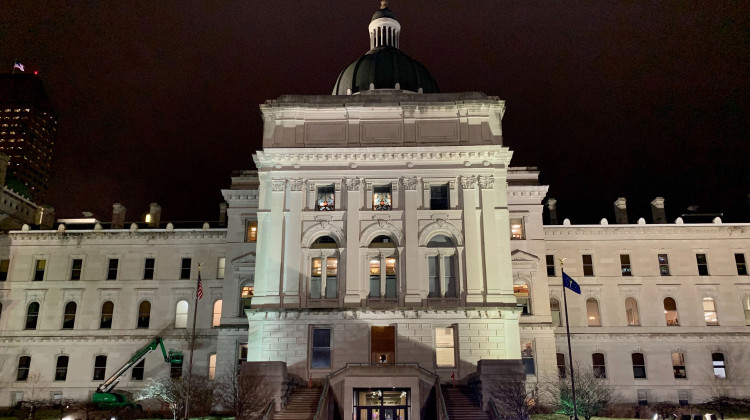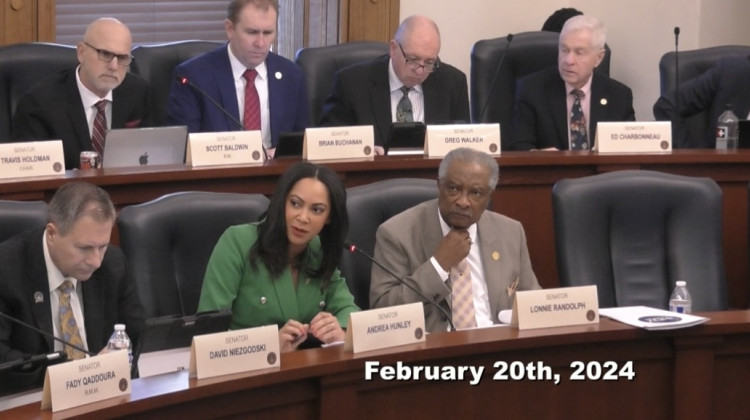
Mike Mitchell sits in front of what was once his childhood home, which is now just weeds and wood scraps.
Annie Ropeik/Indiana Public BroadcastingAfter decades of manufacturing job losses, some Hoosier cities with majority white populations are bouncing back. But Gary, which is mostly black, is still struggling to stabilize.
Mike Mitchell pulls up to an empty lot on a quiet street in Gary and stops his car.
“That’s where we used to stay,” he says.
The house where he grew up was torn down years ago. Now, it’s just weeds and wood scraps.
“In some ways, your memory is gone. You have nothing of it,” he says. “You could take your kids over here and play at the park. The social security building was here, is no longer there. That was the main post office on the corner. Just about everything you needed was right here.”
Back then, Gary was a company town, built around U.S. Steel’s Gary Works plant on the Lake Michigan shore. It was the world’s biggest steel mill in the 1970s, and Mitchell was one of its first black electricians.
But he still faced discrimination – such as the time he was given the wrong test while angling for a promotion.
“I thought it was racial,” he says. “So I went to my general foreman and I asked him about it, and he said, ‘Yeah, I filled that out.’ He said, ‘I made a mistake, but you’re gonna be the one that pays for it.’ And those were his exact words.”
Today, he might have had an advocate like himself to turn to – he spent the rest of his career settling labor disputes and lobbying for trade reforms to benefit steelworkers.
But when it comes to Gary, those efforts don’t seem to be enough.
Gerald Taylor studies this issue at Georgetown University, and for the lobbying group Alliance for American Manufacturing. He says Gary is caught in a vicious cycle.
“The city sort of grew to prominence because of industry and that was its sole source of economic opportunity and revenue and things like that,” Taylor says. “I think in those kinds of places, you do see this pattern play out pretty reliably in the same kinds of ways.”
At the same time as global competition and automation started to take a toll on steel jobs, Gary’s demographics were changing. Its first black mayor was elected as the city’s population shifted from majority white to majority black. And all the while, it was losing jobs.
“These cities, which are becoming increasingly economically distressed, were becoming increasingly concentrated with populations of black people or other minorities at the same time as they were becoming poorer,” Taylor says.
More white families could and did move away. They tended to have more money, and didn’t face something that black families did – discrimination in housing and lending. That made it much harder for black workers to seek new opportunities.
Taylor says that downturn leads to fewer services, crime, blight and health problems. And it discourages new people from moving in.
“The cycle can perpetuate itself, because the momentum behind trying to fix this can just evaporate over time,” he says.
Taylor says trade reforms and economic recovery plans need to take that history into account.
But Gary Chamber of Commerce president Chuck Hughes, who keeps a life-sized cardboard cutout of President Obama in his office in a city housing high-rise, says they haven’t gotten much special treatment.
Gary had hoped to have a monopoly on casinos in Northwest Indiana. Instead, the state opted to spread them across the lakeshore, cutting into Gary’s profits.
“Visionaries downstate and others saw the potential, saw the kind of revenue, and [said] ‘why would we allow that to come to Gary alone?’” Hughes says.
The city was also hard-hit by state property tax caps, which the Indiana Fiscal Policy Institute reported last year have cost older, bigger cities the most. That said, Gary’s population is falling – even as its closest neighbors, the more white cities of Merrillville and Hammond, grow.
Gary Mayor Karen Freeman-Wilson says their economy is diversifying, with work on the airport, an industrial park and lakefront hotel. Still she’s hoping for more investment in infrastructure and manufacturing – perhaps under President-Elect Donald Trump.
Lake County voted against him by a 20-point margin, but Freeman-Wilson still believes a rising tide can lift all boats.
“It’s kind of hard to provide opportunities for one race and not have it provided for others, if you’re talking about industries,” she says.
But Mike Mitchell, the steelworker, isn’t as optimistic as he used to be, as he looks out at rows of shuttered factories and homes in Gary. Still, he says he’ll keep lobbying local governments to boost manufacturing in the region – and in Gary, which he calls a “prime spot.”
“You’ve got the tollway, you’ve got [interstate highways] 80, 94 – I mean, those are ways to get your product out of here,” he says. “The lake sits right there.”
Still, Mitchell wanted better schools, services and neighborhoods for his family, too. They moved from Gary to Merrillville as soon as they could afford it.
 DONATE
DONATE






 View More Programs
View More Programs

 Support WFYI. We can't do it without you.
Support WFYI. We can't do it without you.